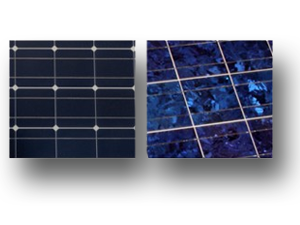Types of solar cells
A solar panel is an assembly of photovoltaic cells. these are the cells that convert sunlight into electricity.
The panel simply, him, to add the currents created to reach a workable level.
There several types of cells which differ in the materials used to construct the. Apart from the price, selecting a type of cell that has little consequences for the user, the main difference is the surface, equal power, may vary from simple to double.
Monocrystalline silicon cells
The monocrystalline silicon cells offer the best performing solar panels commercially available : between 13 with 15%.
This will require fewer cells to achieve the desired power, but as monocrystalline silicon is also the most expensive, its only advantage is finally using a reduced surface : it takes about 7m ² for 1 kiloWatt-crète (kWc).
Cells polycrystalline silicon (ou multicristallin)
The modules using the polycrystalline silicon cells typically have an efficiency of between 12 and 14%. It takes approximately 8m ² cells for 1kWc. These cells are easier to manufacture and cheaper than the monocrystalline silicon cells.
Polycrystalline cells are recognizable to irregularly shaped crystals which appear clearly to the naked eye.

Difference between the monocrystalline silicon cells (left) cells and polysilicon (right)
Amorphous silicon cells
Cells are amorphous silicon thin-film cells, that is to say, they are fabricated by depositing a thin layer of silicon on a support (or “substratum”), for example glass. The thickness of silicon used is much lower than for the mono or polycrystalline cells which are formed from silicon wafers.
This type of cell is cheaper and easier to manufacture. Its thinness allows, for example, to use to create flexible solar panels. However, these cells have limited yields (approximately 5 with 7%, approximately 15m ² for 1kWc) and are reserved for applications requiring low power.
The amorphous silicon cells are widely used for powering small devices solar (shows, calculator…).
Cells using materials other than silicon
These cells are also thin layers, they can be made from various materials : diselenide copper and iridium (CIS), tellurure of cadmium (CdTe)…
They yields between 7 and 11%.
Mention may be made for other types of memory cells very few thin layers on the market or still in research :
- Cells gallium arsenide used mainly in space applications
- Multilayer cells, multijonctions, hybrid or tandem overlap several thin layers to use different wave lengths of light and offer higher yields (sometimes exceeding 40% in laboratoire)
- Organic solar cells created from synthetic materials, therefore cheaper, but still provide a performance and life too low.


